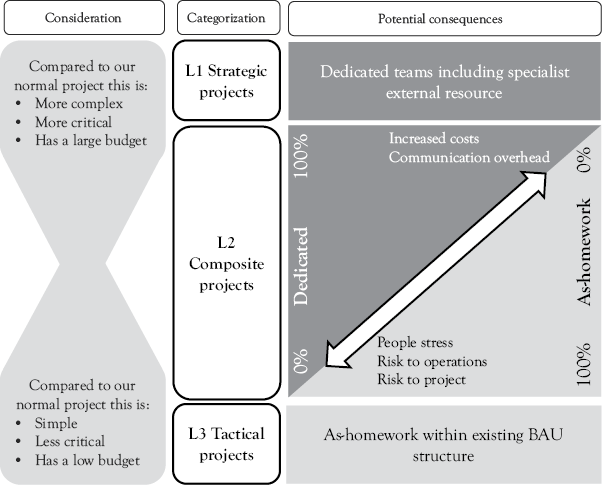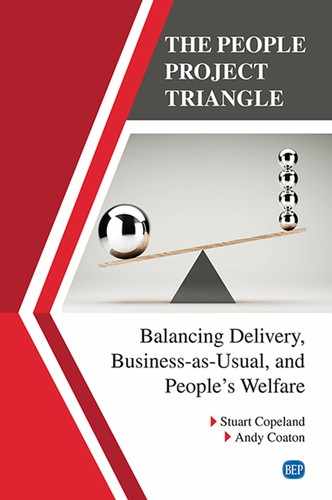Categorizing Your Project
Before you can successfully manage a composite project, you must realize you have one; so, the first task is determining what category of project you have: Level 1, Level 2, or Level 3. These are not absolute categories, as they are relative to your organization and its experience with projects. Consider the project’s complexity, criticality, and budget. You can use Figure 10.1 to guide you.

Figure 10.1 Determining the dedicated or as-homework mix on your project
Complexity
Consider projects your organization has successfully completed or routinely undertakes. How complex is the project compared to those?
If the project is a core strategic initiative or involves major cross-company or inter-company supply chain business transformation, then it is sure to be Level 1. Also, relative to your usual projects, does it involve more departments, a wider range of cross-disciplinary skills, or more coordinated work streams? If yes, then you probably are dealing with a project that should be organized as Level 1.
If the impact of the project is contained within one department and the implementation skills required live within the department, then you have a Level 3 project.
Criticality
Next, consider the impact of success or failure of the project. How far across the organization will the impact be felt? If it is material to the annual profit, then the project is Level 1. If the gains or losses would only be noticed at department level, then the project is Level 3.
Budget
If the budget for the project is toward the top end of project budgets for your organization historically, then you are likely to need to organize as a Level 1. However, if the project falls within the department discretionary budget, it is probably Level 3.
Bringing It Together
If consideration of any of complexity, criticality, or budget is considered Level 1, then Level 1 organization is desirable. Only if all complexity, criticality, or budget considerations are Level 3 is the project likely to be easily organized as a Level 3.
After considering complexity, criticality, or budget and you do not have a Level 1 or a Level 3 project, then you have a Level 2 composite project. It will be a composite with a mix of dedicated and part-time staff with ongoing business-as-usual (BaU) commitments.
What Do We Mean by Dedicated?
Dedicated staff are people whose sole focus in the company is the project. They have no BaU responsibilities and no internal line managers. They could come from the company and be seconded on to the project or be external contractors.
As-homework staff are people who have BaU responsibilities in the company and line managers to report to for the BaU. Line managers who expect the BaU to continue as usual—products and services delivered to customers, end-of-quarter reports produced, performance reviews undertaken, and so on.
Full Time and Part Time
While an as-homework resource is, by definition, internal and part time, a dedicated resource can be either full time or part time. This is because an external resource can be part time, for example, two days a week, but when they are at the company, their only focus is the project. They have no internal line manager to answer to and no company BaU commitments.
How Is a Level 2 Composite Project Resourced?
For the purposes of this book, we use the following terminology to describe the project team. There is a project sponsor who provides the resources and is responsible for realizing the project benefits; a business lead responsible for the business changes once the other project deliverables are in place; and a project manager who manages the project. Workstreams are sub-projects, led by a workstream lead and supported by workstream members and subject matter experts (SMEs).
In the agile world, the project sponsor equates to the product owner; the project manager equates to the scrum master; the workstream lead and workstream members equate to the team members. The business lead is responsible for business changes, irrespective of the techniques used to create project outputs.
Sponsor and business leads: The nature of these project roles means they are always part time.
SMEs: These are usually as-homework and bought in to offer advice as needed.
Project manager and work stream leads: Can either be dedicated or as-homework resources. These are the first roles to be assigned as dedicated and the easiest to outsource to external project management professionals. Project management is a specialist skill the project will almost certainly benefit from someone with this training and experience. Additionally, the project needs a champion. Someone with a partisan interest in the success of the project, and only the success of the project, undiluted by considerations and internal politics from other organizations considerations.
Team members, the doers: a mix of dedicated and as-homework resources.
Pros and Cons for a High Dedicated Mix
A dedicated team focused on the single task of delivering the desired outcome is the most effective way to ensure it gets done. This is achieved by incurring the increased costs of those dedicated resources. The other key cost relates to communication overhead. Unless the dedicated team is all drawn from the business areas affected, then they will need to learn about the business and a lot of that learning will be from the staff in the business.
Pros and Cons for High As-Homework Mix
A dedicated team is expensive. An as-homework resource is expected to fit in the extra work around their normal work, but of course, there are not many staff in modern lean organizations with spare capacity to tap.
Alternatively, in many cases, the people with the skills, knowledge, and experience for the project cannot easily have their BaU roles covered by other in-house or external people.
So, as discussed elsewhere on the people project triangle, this form of organization comes with the risk of damage to either the staff resulting in stress, the operations or BaU because it is neglected, or if the staff cannot spend enough time on the project, then the project suffers from compromised quality, slipped timescales, or scaled back scope.
As you go into your project and design its organization structure, it is important to go in with your eyes wide open. Projects as-homework are a fact of modern business and will have to be done. We hope to make you aware of the risks so that you can look out for them and to give you some idea of the ways we have found to temper those risks as far as possible.
Story: Compliance Conundrum
The following story illustrates how important it is to recognize a composite project and, then, to ensure it is resourced appropriately.
A UK importer of consumer goods was wrestling with new government rules affecting the products in their sector. The manufacturer of those products had to increase the amount of testing done on its goods. It was having a big detrimental effect on its ability to meet demand in its markets across the world. One of the authors was engaged by the importer to help plan out the work required to overcome the supply issues.
There was an initial workshop to dig down into the detail of the issues faced. It was causing pain across all areas of the business. A second workshop was run with 20 senior managers with the objective of identifying solutions, resources, and approximate timescales.
The proposed project was complex and critical to the future of the organization. However, what was apparent very early on was that for the work required, we needed the expertise of a big group of people around the business. These key people were in separate small teams, so it was virtually impossible to backfill their roles while they were attached to the project. It was clearly a composite project, and so, we needed to find a way to support the business while this additional work was ongoing.
It is easy for people to claim they require more resources and easy for organizations to say no. In this case, the detailed work following the second workshop provided the evidence that the project would break BaU without changes to timetable, or additional resources or funding. The option to slip deadlines was not available because they were legislative.
In this case, the diagnosis as a composite project allowed the importer to set its priorities for the rest of the year. This enabled the business to adopt tactics to protect BaU performance, ensure that the project was delivered, and reduce the risk that people were completely frazzled.
